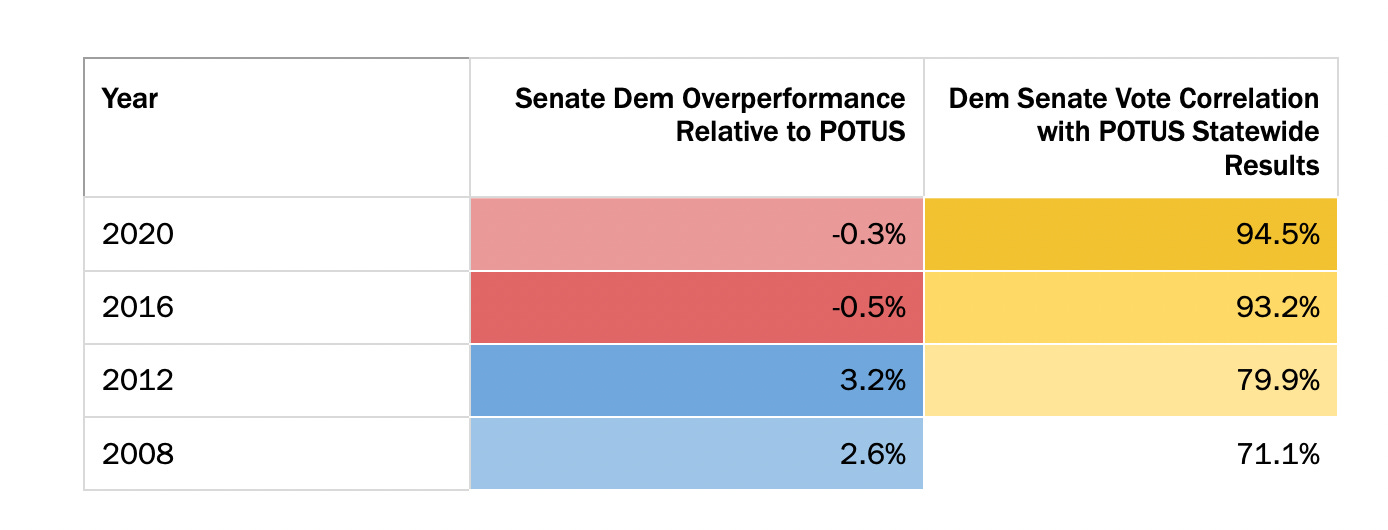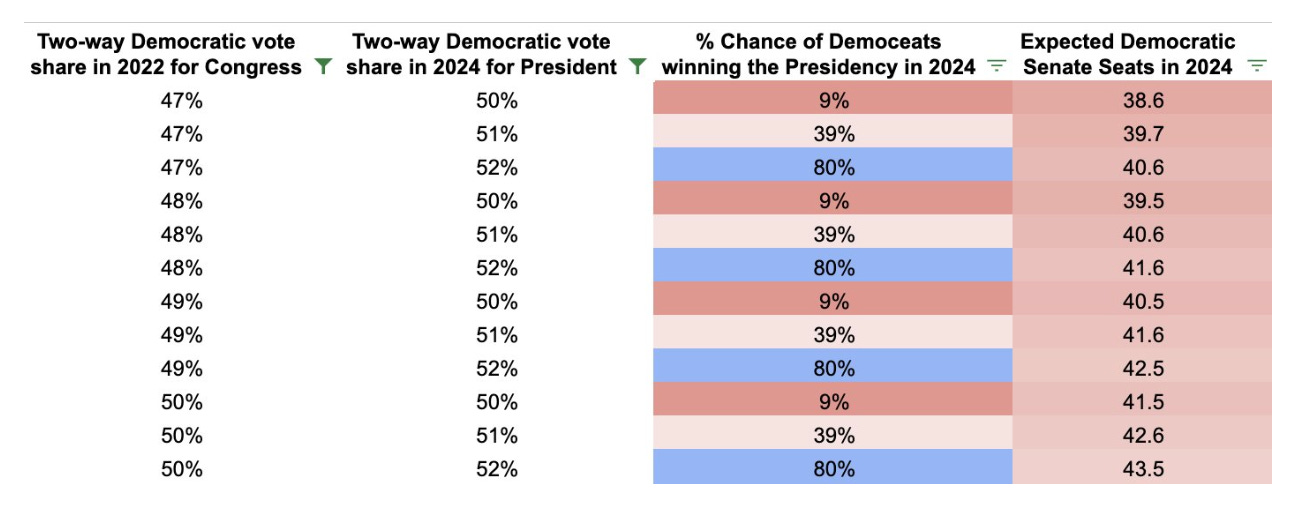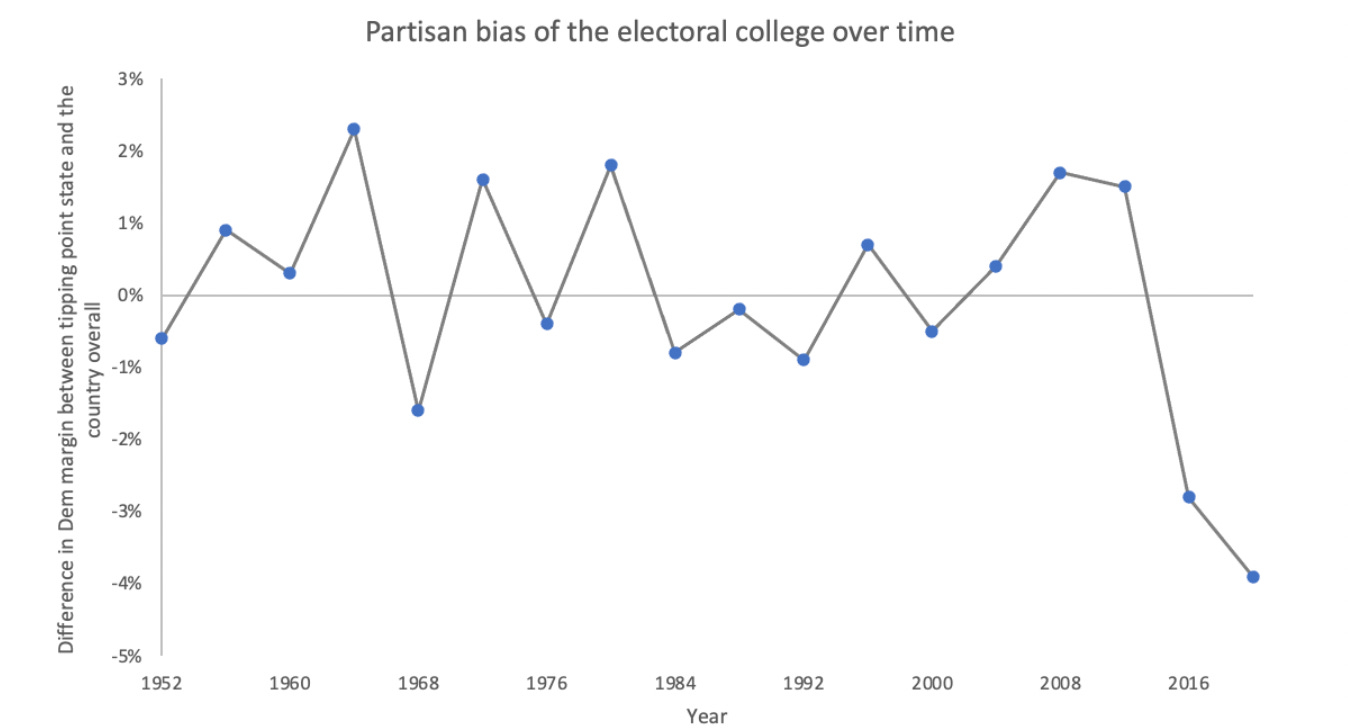Traditionally, the President’s party averages roughly 47.5% of the two-party vote in midterms. Right now, in FiveThirtyEight's average of public polls, Democrats are polling at 48.7%. However, the President’s party also tends to decline in standing as the midterms approach, as the graph below shows (you can read more about the historical evidence for this decline here). The one clear exception involved the 9/11 terrorist attacks and does not offer Joe Biden grounds for optimism.
Additionally, polls have been biased towards Democrats in two of the last three cycles, and there is reason to think this bias will persist. The current 48.7% polling average may well be an overestimation.
Between those two factors, it’s reasonable to assume that Democrats are looking at a vote share between 47% and 48.5% this cycle. This means Republicans will probably win the generic ballot by between three and six percent, and the median scenario is probably Republicans winning by around 4.5%. Since Joe Biden won by 4.5% in 2020, this would mean that the national environment has shifted 9 percentage points to the right.
Assume, for a moment, that there is zero ticket-splitting, and this swing is uniform across all elections. This would mean any Democrat in a state that Biden won by less than 9% will probably lose. That includes:
Mark Kelly in Arizona (Biden +0.3)
Raphael Warnock in Georgia (Biden +0.2)
Catherine Cortez-Masto in Nevada (Biden +2.4)
Maggie Hassan in New Hampshire (Biden +7.4)
Both zero ticket-splitting and literally uniform national swings are simplifying assumptions; reality will be a bit more complicated. Incumbency advantage, in particular, might help stem the bleeding a little. But take a look at the table below, courtesy of David Shor, head of Data Science at Blue Rose Research (where I work). Both ticket-splitting and incumbency advantage have declined precipitously in recent years, and are both now near zero:
Overall, the combination of decreasing incumbency advantage and a poor national environment for Democrats means we should probably expect Democrats to control between 46 and 47 Senate seats after 2022 — depending, essentially, on whether or not Maggie Hassan manages to hold her seat in New Hampshire. And indeed, that’s what betting markets like PredictIt seem to think will happen.
The 2024 map is much worse
Since the Reagan Era, Democrats have averaged roughly 51% of the two-party vote in Presidential elections. If Biden gets this percentage of the vote, and the correlation between the Senate and presidential vote stays at close to .95 (as it was in 2020), then basically every Democratic senator in a state Biden won by less than 2% who is up in 2024 is likely to lose.
That includes:
Jon Tester in Montana (Biden -16.3)
Joe Manchin in West Virginia (Biden -29.9)
Sherrod Brown in Ohio (Biden -8)
Bob Casey in Pennsylvania (Biden +1.2)
Tammy Baldwin in Wisconsin (Biden +0.7)
Kyrsten Sinema in Arizona (Biden +0.3)
In addition, Debbie Stabenow in Michigan (Biden +2.8) and Jackie Rosen in Nevada (Biden +2.4) would likely be in toss-up races.
Putting it all together
The above scenarios are designed to illustrate plausible outcomes, and they’re specific to certain assumptions about Democrats’ performance in the 2022 and 2024 elections. You might think these assumptions are wrong. So below is a “choose your own adventure” for Senate forecasts. Start on the left with the share of the vote you think Democrats will get in 2022, then pick your estimate of the Democratic vote share in 2024. The output in the right-most column is, according to David Shor’s modeling, the projected number of Senate seats Democrats will hold after the 2024 elections.
As the table demonstrates, “normal” electoral results will likely result in the loss of a large share of the Democratic Senate Caucus — pessimism about the outlook here is not driven by any particular pessimism about Democrats’ share of the national popular vote.
Instead, the issue is that the growing polarization of the electorate around educational attainment and the urban/rural divide has generated a Senate that is incredibly biased against the Democratic party.
Meanwhile, the Electoral College is more biased than ever:
If Joe Biden receives 51% of the vote in 2024 (again, this is the long-run average for Democratic presidential candidates), he will likely lose the Electoral College — and with it, the presidency.
“Business as usual” will result in President Trump or President DeSantis, with somewhere between 56 and 62 Senate seats. And this is actually worse than it might seem at first. In recent years, Republican senators who have retired (or announced that they are retiring) have skewed heavily toward those who were willing to occasionally stand up to Trump, like Jeff Flake, Lamar Alexander, Rob Portman, Pat Toomey, and Richard Burr. If Trump returns to office, he will do so with a median Senator who is far more deferent to his wishes than the last time around.
Hope is not a plan
Of course, these dire predictions may not come to pass. Maybe Democrats will get 50% of the vote in 2022 (though this is looking more and more like a lost cause), and maybe they’ll follow that up with 54% of the vote in 2024. Then Biden will stay President, and Republicans will only have a slim Senate majority in 2024 — 53 seats instead of 58 or so.
This “optimistic” scenario is possible; Presidents have won re-election by more than 8% before. The bias of the maps is also not a law of nature. While it didn’t impact election outcomes, 2004, 2008, and 2012 all featured a modest Electoral College bias in favor of the Democratic Party coalition, offset by a modest Senate bias in favor of the GOP. In theory, Biden could shift back to Obama’s less-educated, more-rural pattern of support, reducing the Democratic party’s electoral disadvantage.
But it’s important to stress that this is not the business as usual case. The way-too-early 2024 polling has Biden and Trump tied in a hypothetical rematch. Betting markets have Republicans favored to retake the presidency. Democrats drawing even with Republicans in the popular vote in 2022 would be surprising, as would Biden winning reelection by more in 2024 than he did in 2020. A large realignment of demographic voting patterns, with rural and working-class voters returning to the Democratic party, seems even more improbable given the party’s current trajectory.
And neither an 8% landslide in 2024 nor a reshaping of electoral coalitions will happen by chance. The administration and the reelection campaign would have to make different tactical choices than the ones they’ve been making.
What tactical choices should they make? That’s a hard question, and it’s one I’ll be writing a lot more about in the months to come. But before you can solve a problem, you have to acknowledge that you have one. Aiming for 51-52% of the vote under the current coalitional pattern won’t cut it. Democrats need to wake up, because right now they’re sleepwalking into disaster, with no plan to avert it.





No comments:
Post a Comment